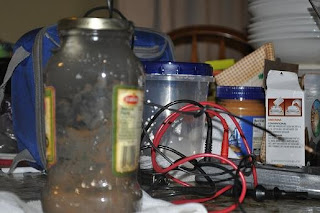
I created one very small microbial fuel cell using the my Winogradsky column from the fall semester, whose original contents were from Bear Creak. If I had mentioned before that there was no significant smell from this column, I was apparently not poking around enough. There was plenty of sulfuric smell coming from the column as I transferred it and the corresponding creak water into the MFC container. I used a 24 ounce spaghetti sauce jar.
The anode section of the cell was made with a graphite pencil from the art store. The protocol in the research paper asks for carbon paper, but since our entire class is using graphite, I went with graphite. We also drilled all the way through the graphite and used a nut and bolt to connect the electrical wire. Because my husband, the airplane mechanic, was convinced that this would work, we then coated this area with sealant to help protect against corrosion. Since we had used a nut and bot to connect the wire, we did not use an additional connective epoxy. The anode section was then gently placed in the sediment and covered with it at the bottom of the jar. I mixed about a 1/2 teaspoon of sugar into the mud while doing this.
The water from the column was added to the jar until it filled the jar to the surface. The Cathode was placed in immediately after. It was made in the same way as the anode. A 100 ohm resistor was placed between the wires. I tested the volts immediately after putting everything together (too soon)? I'm going to need to get guidance on the voltmeter. I am not sure what measurement everyone is using, but I read 9 micro volts initially and after 3 hours I'm down to about 3 micro volts. We'll see how this goes with time!




No comments:
Post a Comment